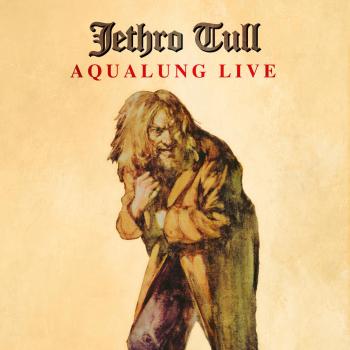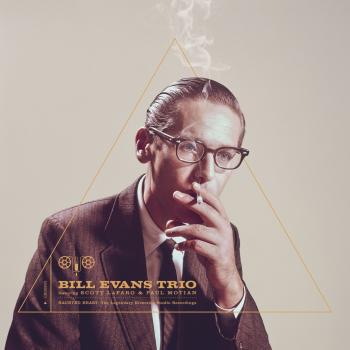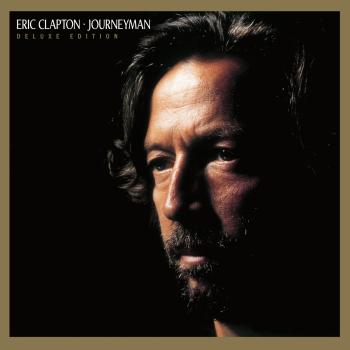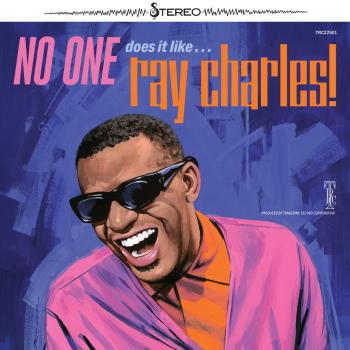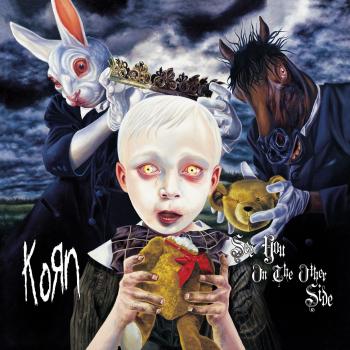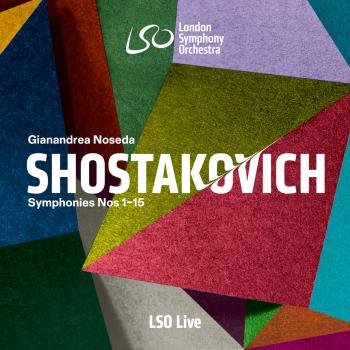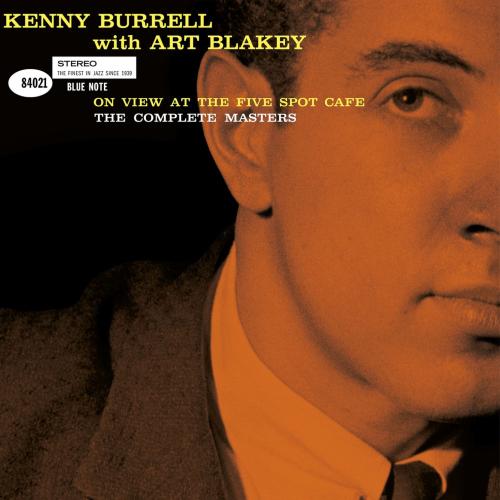
On View At The Five Spot Café: The Complete Masters (Live) (Remastered) Kenny Burrell & Art Blakey
Album Info
Album Veröffentlichung:
2025
HRA-Veröffentlichung:
25.04.2025
Das Album enthält Albumcover
Entschuldigen Sie bitte!
Sehr geehrter HIGHRESAUDIO Besucher,
leider kann das Album zurzeit aufgrund von Länder- und Lizenzbeschränkungen nicht gekauft werden oder uns liegt der offizielle Veröffentlichungstermin für Ihr Land noch nicht vor. Wir aktualisieren unsere Veröffentlichungstermine ein- bis zweimal die Woche. Bitte schauen Sie ab und zu mal wieder rein.
Wir empfehlen Ihnen das Album auf Ihre Merkliste zu setzen.
Wir bedanken uns für Ihr Verständnis und Ihre Geduld.
Ihr, HIGHRESAUDIO
- 1 Birk's Works (Live At Five Spot Café, 1959) 09:47
- 2 Hallelujah (Live At Five Spot Café, 1959) 11:40
- 3 Lady Be Good (Live At Five Spot Café, 1959) 10:00
- 4 Lover Man (Live At Five Spot Café, 1959) 08:23
- 5 36-23-36 (Live At Five Spot Café, 1959) 03:49
- 6 Swingin' (Live At Five Spot Café, 1959) 09:48
- 7 If You Could See Me Now (Live At Five Spot Café, 1959) 05:25
- 8 Beef Stew Blues (Live At Five Spot Café, 1959) 04:32
- 9 The Next Time You See Me, Things Won't Be The Same (Live At Five Spot Café, 1959) 07:30
- 10 The Take Off (Live At Five Spot Café, 1959) 05:30
- 11 Birks Works (Alternate Take / Live At Five Spot Café, 1959) 09:39
- 12 Lady Be Good (Alternate Take / Live At Five Spot Café, 1959) 09:55
- 13 Love Walked In (Live At Five Spot Café, 1959) 05:45
- 14 36-23-36 / The Theme (Live At Five Spot Café, 1959) 12:41
Info zu On View At The Five Spot Café: The Complete Masters (Live) (Remastered)
Guitarist Kenny Burrell had already achieved rising star status with several stellar Blue Note albums to his name when he entered the storied NYC jazz club The Five Spot Café on August 25, 1959 to record "On View At The Five Spot Café". The band Burrell assembled for the gig was stacked with top talent: Art Blakey on drums, Tina Brooks on tenor saxophone, Roland Hanna and Bobby Timmons on piano, and Ben Tucker on bass. The mood was relaxed and soulful, but the music was red hot and the grooves were deep on that steamy summer evening of hard bop bliss.
The newly remastered HiRes-Edition of On View At The Five Spot Café: The Complete Masters gives the listener the best seat in the house and marks the first time Burrell’s complete recorded performances from that magical evening have been made available in any format, including six previously unreleased tracks. This deluxe tri-fold edition includes a plethora of great editorial, with never-before-seen Francis Wolff photos, essay by Syd Schwartz and an insightful new interview of Kenny Burrell by Don Was.
„Das war ein echter Jazzclub“, erinnert sich Burrell. „Es war schön, dort zu spielen, denn man wusste, dass das Publikum jazzig anspruchsvoll war. Sie kannten die Jazzmusiker und erwarteten ein gewisses Jazzniveau, wenn man im Five Spot spielte. Ich war froh, als Musiker dort zu sein.“ (Kenny Burrell)
„Das ist schon lange eines meiner Lieblings-Live-Jazzalben, das ich vor über 50 Jahren im College entdeckt habe“, sagt Harley. „Es herrscht eine so tiefe und entspannte Atmosphäre, die Jungs kannten sich offensichtlich gut und fühlten sich beim Auftritt sehr wohl. Ich wünschte immer, ich hätte dabei sein können. Als wir die Masteraufnahmen machten, fühlte es sich an, als wäre mein Wunsch in Erfüllung gegangen. Und noch besser: Es gab so viele großartige Stücke, die ich noch nie zuvor gehört hatte! Reisen wir zurück zum 25. August 1959 und treffen uns im Five Spot Café in New York City zu einem herausragenden Jazzabend!“ (Joe Harley)
Kenny Burrell, Gitarre
Tina Brooks, Tenorsaxophon (Tracks 1–4)
Bobby Timmons, Klavier (Tracks 1–4)
Roland Hanna, Klavier (Tracks 5–8)
Ben Tucker, Bass
Art Blakey, Schlagzeug
Aufgenommen am 25. August 1959 live im Five Spot Café, New York City
Tontechnik: Rudy Van Gelder
Mastering: Kevin Gray, Cohearent Audio
Produziert von Alfred Lion
Digital remastered
Kenny Burrell
One of the leading exponents of straight-ahead jazz guitar, Kenny Burrell is a highly influential artist whose understated and melodic style, grounded in bebop and blues, made him in an in-demand sideman from the mid-’50s onward and a standard by which many jazz guitarists gauge themselves to this day. Born in Detroit in 1931, Burrell grew up in a musical family in which his mother played piano and sang in the Second Baptist Church choir and his father favored the banjo and ukulele. Burrell began playing guitar at age 12 and quickly fell under the influence of such artists as Charlie Christian, Django Reinhardt, Oscar Moore, T-Bone Walker, and Muddy Waters. Surrounded by the vibrant jazz and blues scene of Detroit, Burrell began to play gigs around town and counted among his friends and bandmates pianist Tommy Flanagan, saxophonists Pepper Adams and Yusef Lateef, drummer Elvin Jones, and others.
In 1951, Burrell made his recording debut on a combo session that featured trumpeter Dizzy Gillespie as well as saxophonist John Coltrane, vibraphonist Milt Jackson, and bassist Percy Heath. Although his talent ranked among the best of the professional jazz players at the time, Burrell continued to study privately with renowned classical guitarist Joe Fava and enrolled in the music program at Wayne State University. Upon graduating in 1955 with a B.A. in music composition and theory, Burrell was hired for a six-month stint touring with pianist Oscar Peterson’s trio. Then, in 1956, Burrell and Flanagan moved to New York City and immediately became two of the most sought-after sidemen in town, performing on gigs with such luminaries as singers Tony Bennett and Lena Horne, playing in Broadway pit orchestras, as well as recording with an array of legendary musicians including Coltrane, trumpeter Kenny Dorham, organist Jimmy Smith, vocalist Billie Holiday, and many others. Burrell made his recorded debut as a leader on the 1956 Blue Note session Introducing Kenny Burrell — technically his second session for the label, but the first to see release. From the late ’50s onward, Burrell continued to record by himself and with others, and has appeared on countless albums over the years including such notable albums as 1957’s The Cats featuring Coltrane, 1963’s Midnight Blue featuring saxophonist Stanley Turrentine, 1965’s Guitar Forms with arrangements by Gil Evans, and 1968’s Blues — The Common Ground.
Beginning in 1971, Burrell started leading various college seminars including the first regular course to be held in the United States on the music of composer, pianist, and bandleader Duke Ellington. He continued performing, recording, and teaching throughout the ’80s and ’90s, releasing several albums including 1989’s Guiding Spirit, 1991’s Sunup to Sundown, 1994’s Collaboration with pianist LaMont Johnson, 1995’s Primal Blue, and 1998’s church music-inspired Love Is the Answer. In 2001, Burrell released the relaxed quartet date A Lucky So and So on Concord and followed it up in 2003 with Blue Muse. He celebrated turning 75 years old in 2006 by recording a live date, released a year later as 75th Birthday Bash Live! In 2010, Burrell released another live album, Be Yourself: Live at Dizzy’s Club Coca-Cola, recorded at Lincoln Center’s smaller club-like venue. Besides continuing to perform, Burrell is the founder and director of the Jazz Studies Program at UCLA as well as President Emeritus of the Jazz Heritage Foundation. (Matt Collar, AMG)
Art Blakey
Born in 1919, Art Blakey began his musical career, as did many jazz musicians, in the church. The foster son of a devout Seventh Day Adventist Family, Art learned the piano as he learned the Bible, mastering both at an early age.
But as Art himself told it so many times, his career on the piano ended at the wrong end of a pistol when the owner of the Democratic Club — the Pittsburgh nightclub where he was gigging — ordered him off the piano and onto the drums.
Art, then in his early teens and a budding pianist, was usurped by an equally young, Erroll Garner who, as it turned out, was as skilled at the piano as Blakey later was at the drums. The upset turned intoa blessing for Art, launching a career that spanned six decades and nurtured the careers of countless other jazz musicians.
As a young drummer, Art came under the tutelage of legendary drummer and bandleader Chick Webb, serving as his valet. In 1937, Art returned to Pittsburgh, forming his own band, teaming up with Pianist Mary Lou Williams, under whose name the band performed.
From his Pittsburgh gig, Art made his way through the Jazz world. In 1939, he began a three-year gig touring with Fletcher Henderson. After a year in Boston with a steady gig at the Tic Toc club, he joined the great Billy Eckstine, gigging with the likes of Charlie Parker, Dizzy Gillespie, and Sarah Vaughn.
In 1948, Art told reporters he had visited Africa, where he learned polyrhythmic drumming and was introduced to Islam, taking the name Abdullah Ibn Buhaina. It was in the late ’40s that Art formed his first Jazz Messengers band, a 17-piece big band.
After a brief gig with Buddy DeFranco, in 1954 Art met up with pianist Horace Silver, altoist Lou Donaldson, trumpeter Clifford Brown, and bassist Curly Russell and recorded "live" at Birdland for Blue Note Records. The following year, Art and Horace Silver co-founded the quintet that became the Jazz Messengers. In 1956, Horace Silver left the band to form his own group leaving the name, the Jazz Messengers, to Art Blakey.
Art’s driving rhythms and his incessant two and four beat on the high hat cymbals were readily identifiable from the outset and remained a constant throughout 35 years of Jazz Messengers bands. What changed constantly was a seeming unending supply of talented sidemen, many of whom went on to become band leaders in their own right.
In the early years luminaries like Clifford Brown, Hank Mobley and Jackie McLean rounded out the band. In 1959, tenor saxophonist Benny Golson joined the quintet and — at Art’s behest — began working on the songbook and recruiting what became one of the timeless Messenger bands — tenor saxman Wayne Shorter, trumpeter Lee Morgan, pianist Bobby Timmons and bassist Jymmie Merritt.
The songs produced from ’59 through the early ’60s became trademarks for the Messengers — including Timmon’s Moanin’, Golson’s Along Came Betty and Blues March and Shorter’s Ping Pong.
By this time, the Messengers had become a mainstay on the jazz club circuit and began recording on Blue Note Records. They began touring Europe, with forays into North Africa. In 1960, the Messengers became the first American Jazz band to play in Japan for Japanese audiences. That first Japanese tour was a high point for the band. At the Tokyo airport, the band was greeted by hundreds of fans as Blues March played over their airport intercom and their visit was televised nationally.
In 1961, trombonist Curtis Fuller transformed the Messengers into a proper sextet, giving the band the opportunity to incorporate a big band sound into their hard bop repertoire. Throughout the ’60s, the Messengers remained a mainstay on the jazz scene with jazz greats including Cedar Walton, Chuck Mangione, Keith Jarrett, Reggie Workman, Lucky Thompson and John Hicks. In the jazz drought of the ’70s, the Messengers remained a strong force, with fewer recordings, but no less energy. At a time when many jazz musicians were experimenting with electronics and fusing their music with pop, the Messengers were a mainstay of straight-ahead jazz.
Art’s steadfast belief in jazz music left him well positioned to take advantage of the music’s resurgence in the early ’80s. Art had been working with musicians including trumpeter Valery Ponomarev, tenor Billy Pierce, alto saxman Bobby Watson and pianist James Williams. Trumpeter Wynton Marsalis’ 1980 entrance into the band coincided — and played no small part in — the resurgence of the music in the ’80s.
Throughout the ’80 and until his death in 1990, Art maintained the integrity of the message, incubating the careers of musicians including trumpeters Wallace Rooney and Terence Blanchard, pianists Mulgrew Miller and Donald Brown, bassists Peter Washington and Lonnie Plaxico and many others.
Art died at the age of 71 after a career that spanned six of the best decades of jazz music. The messenger has moved on, but his message lives on in the music of the scores of sidemen whose careers he nurtured, the many other drummers he mentored and countless fans who have been blessed to hear the Messengers’ music. (By Yawu Miller, Managing Editor, The Baystate Banner (Boston, MA)
Dieses Album enthält kein Booklet


